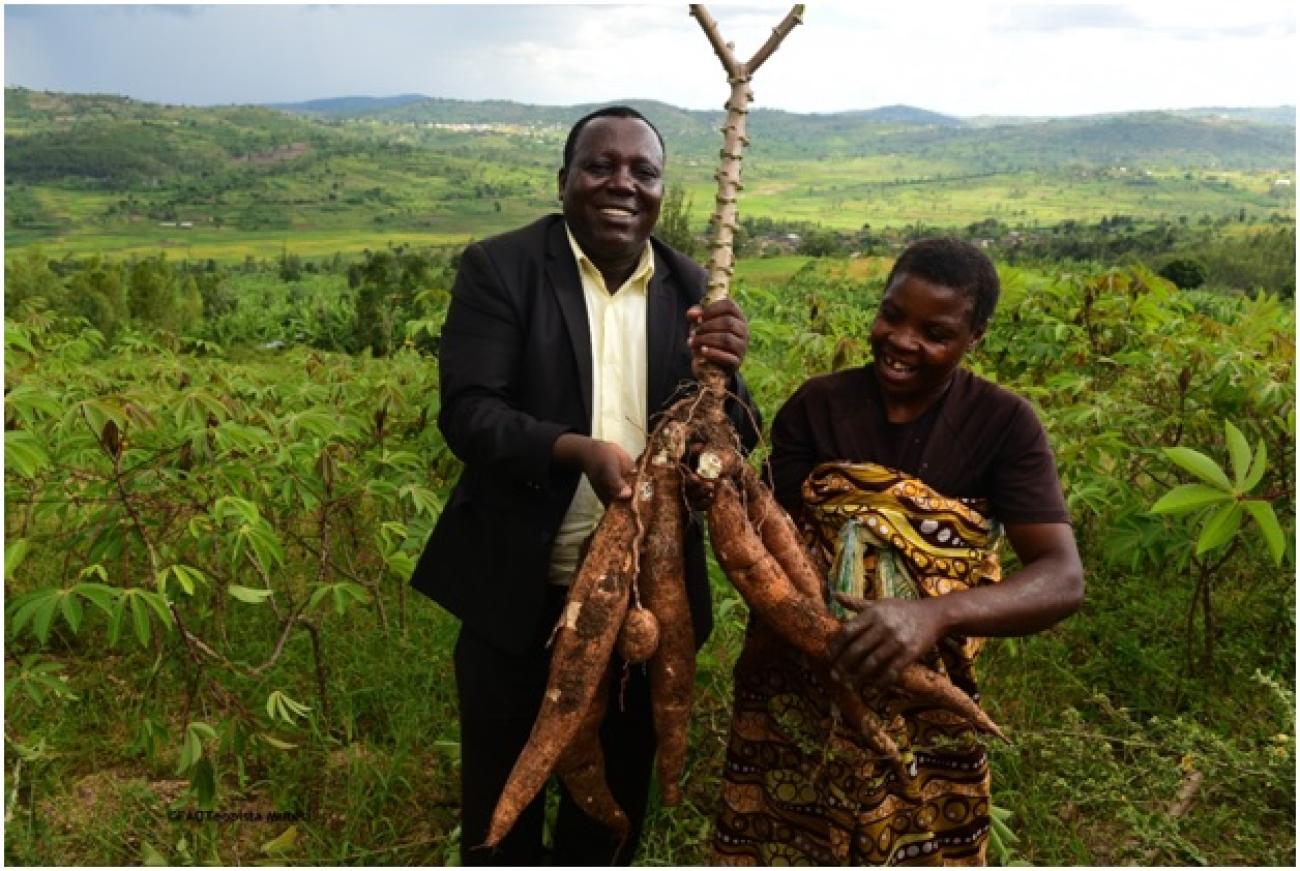Restoring cassava farming in Rwanda

Felicien Simpunga grew up in the Ruhango district of Rwanda, where life and making a living revolved around agriculture.
While he grows other crops such as beans and sweet potatoes for home use, Felicien decided to focus on cassava to earn an income after attending a training course delivered by the Food and Agriculture Organization of the United Nations (FAO) in 2005. When the Kinazi Cassava Plant was established in 2012 and became his main client, his choice seemed to be paying off and he decided to set up a small factory to process raw dried cassava into flour, which he could then sell at a higher price than unprocessed cassava.
This dream came to a halt in 2014 however, with the outbreak of Cassava Brown Streak Disease (CBSD), known locally as Kabore. In 56 years, Felicien had never seen such an intense CBSD outbreak. All eight hectares of his cassava plants were infested and had to be uprooted. “The impact was devastating. I had taken a bank loan of 15 million Rwandan Francs (USD 16 300) that I haven’t been able to pay back. My four children could no longer go to school. All the workers on my farm lost their jobs and income too”, he said. The CSBD outbreak wrought serious damage on Rwanda’s leading cassava-producing districts of Bugesera, Gisagara, Kamonyi, Nyanza, Muhanga and Ruhango.
Of the three staple food crops in Rwanda (cassava, maize and potatoes), cassava makes up nearly one-quarter of production. An FAO assessment on the impact of CBSD showed some farms had lost their entire cassava yield, with the disease incidence soaring from 18.5 percent in 2012 to 69 percent by 2014. This meant that people in affected districts were going hungry and losing their earnings.
Rapid response to control CBSD
Mr Telesphore Ndabamenya, Deputy Director General of the Rwanda Agriculture and Animal Resources Development Board (RAB) which led the Government’s efforts to contain the outbreak, noted that FAO’s timely support was critical in containing the disease’s rapid spread. With financial support from the Government of Belgium, FAO provided a rapid response in two stages: first by importing CBSD-free cuttings from Uganda for the planting seasons in September–December 2014 and February–June 2015, then by implementing sustainable, long-term CBSD control strategies and reinforcing national capacities for disease identification, diagnosis and surveillance.
Introducing CBSD-resistant cassava varieties
“In 2010 there was significant scarcity of cassava seedlings in the country, and the disease was spreading very fast. Over 80 percent of all farms in the three districts were affected,” notes Aime Parfait Gasana, Head of RAB in the southern province. Parfait explains that the problem was exacerbated by poor farming practices, a lack of high quality, disease-free planting materials, and low awareness or knowledge of pest and disease management among farmers, who were growing varieties that had been introduced in the 1960s.
Through the FAO projects, scientists from RAB conducted a due diligence survey on cassava multiplication fields in Uganda. Field screening and pre-testing identified the NASE (Namulonge Selection) 14 Variety as the most resitant to CBSD, and about 14 887 million cuttings of this variety were then imported to Rwanda and planted on 723 hectares in uncontaminated research stations and farmer cooperatives’ fields in 12 districts. The disease-free multiplication plots produced over 38.5 million new cuttings, which were redistributed to 272 farmers in the same districts to avoid further spread of CBSD. This enabled them to restart planting in September 2015 and produce a harvest that restored their livelihoods in a relatively short time.
Improving food access and availability
According to the last Comprehensive Food Security and Vulnerability Analysis (CFSVA) carried out in 2015, the spread of CSBD caused a significant drop in cassava production, particularly in the southern province. In 2014, national production dropped from 3.3 million tonnes to 900 000 tonnes and by April 2015 cassava flour prices were more than 45 percent higher than the five-year average.
Emile Nsanzabaganwa is the General Manager of the Kinazi Cassava Plant in Ruhango District, which was not spared from the CBSD outbreak: “The plant would have closed down if it hadn’t been for the intervention of agricultural stakeholders. We had to import cassava from neighbouring countries, which increased the cost of production and caused the price of cassava flour to skyrocket,” notes Emile. “The factory price of increased three times, from RWFR 500 Francs (0.50 USD) to to RWFR 1 600 Francs (1.75 USD) per kilo, Emile added.
Restoring local economies, businesses and livelihoods
Both farmers and cassava flour producers agree that the NASE14 variety is very productive, the roots and leaves taste better than other varieties and the flour is very white. With this variety, Felicien has recovered his livelihood. “From one hectare, I harvested around 25 to 30 tonnes. With the old varieties, I used to harvest just 12 tonnes on the same land”, he noted happily.
In 2018 he sold 125 tonnes of cassava to the Kinazi Cassava Plant, in addition to drying it for sale at different markets across the country. The Kinazi Plant has also been restored: after FAO and the Government’s intervention, production increased from 900 tonnes in 2017 to 180 million tonnes in 2018, and the price of flour was restored to RWFR 400 per kilo. The challenge now is to find buyers for all the farmers’ produce.
Building on achievements
The Government of Rwanda has since intensified research into new cassava varieties that are high-yielding and resistant to pests and diseases. Two varieties – the Gahene II and Ndamirabana VII – will soon be released to farmers, with four more currently undergoing further testing and development. FAO and RAB are committed to strengthening awareness campaigns targeted at farmers on good agricultural practices and control and management of different pests and diseases. Local farmers are encouraged to buy seedlings from reliable sources and to grow tested and approved varieties and adopt better farming practices.





